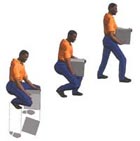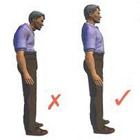SPINE POSTURE
How Poor Posture Happens
Poor posture is easy whereas adapting habits of good posture often require conscious effort. Most people do not think about their posture until someone brings it to their attention. The benefits of good posture far outweigh the ease of slouchy poor posture. During our covid-19 restrictions we were forced to school and work from home. Often long hours behind a computer or tablet. This position of leaning forward with the shoulders slouched and arms extended in front creats an over-use aggravation of the mid-back muscles.
You could say that poor posture habits have followed trends in society. Children carry huge over loaded backpacks, adults lug briefcases to work, and thousands of people spend hours hunched over a computer whether for work or play.
Poor posture is not only habitual, but is also seen in people with low self esteem, degenerative problems affecting the spine, pain causing muscle guarding, and obesity.
Change takes willpower! However… the rewards of good posture are well worth the effort. You will feel great and your physical appearance will look tall and confident!
What Does Good Posture Look Like?
The body is straight, but not robotic! The appearance is relaxed as the ears, shoulders, hips, knees and ankles align in one straight line. If you hung an imaginary plumb line from the earlobe, the line would hang straight through the middle of the anklebone.
Good posture means there is musculoskeletal balance. This balance helps to protect the joints in the spine from excessive stressand maintain better spine posture Illinois. It also guards against injury and possible deformity. Good posture is a great ‘tool’ to possess to help prevent pain.
Starting Your Day
- Stand up and stretch your arms above your head! The American Chiropractic Association (ACA) suggests, “Do the ‘hug your best friend. ‘ Wrap your arms around your body and turn as far as you can to the left, then to the right. “
- Exercise regularly to keep the abdominal muscles strong to help support the spine.In order to get any kind of help for your spine posture St. Louis, Missouri, Illinois, get help from the professionals.
- Avoid wearing high–heeled shoes. Choose shoes that offer good foot support and comfort. Some styles can affect the body’s center of gravity. Flat shoes are better.
- Look at yourself in the mirror. Is your posture good? Think about your posture and how to maintain it throughout the days’ activities. Practice makes perfect!
Purses-Backpacks-Briefcases
Carry only the items that are required for each particular day. Avoid a heavy purse (tote, bag) worn over one shoulder. This can place too much weight on one side of the body and can cause neck, shoulder, and back pain. If you must use a bag or briefcase with a single strap, make sure the strap is padded and wide. The ACA suggests wearing a strap that is long enough to place over the head resting on the opposite side of the bag or briefcase. This can help to distribute the weight more evenly.
People of all ages use a backpack today like preschoolers, students, office employees, teachers, backpackers, even grandparents! Many people pack the backpack to its absolute capacity! Some children carry almost as much weight in their backpack as they weigh! A loaded backpack should not exceed 15% of the body’s weight and never more than 25 pounds! Consider the following backpack tips:
- Choose a backpack made of a lightweight material.
- Make sure the shoulder straps are adjustable, wide and padded. A backpack with a waist/hip strap is preferable. Wear the pack with both shoulder straps and hip strap.
- Pack the heavier items close to the back. Backpacks with many compartments will help you equalize and distribute the load. Pointy objects should be packed away from the wearer’s spine.
- Parents can talk to their child’s teacher and arrange for a separate set of books to be kept at home eliminating the need to haul books back and forth.
Working at a Desk-Posture Friendly Tips
- Choose office furniture that is ergonomically designed and that fits your body.
- Sit with your back against the back of the chair with knees at hip level. Consider using a footrest. A small pillow or rolled towel placed at the lower back can offer needed support.
- The workstation or desk should be at elbow height. Adjust chair height to meet this need.
- Sit with your shoulders straight and parallel to the hips.
- Don’t slouch or lean forward to view work or the computer monitor. Either move closer to the work or move the work closer to you. Tilt the monitor so the center of the screen is at eye level for easy viewing.
- Don’t cradle the phone between your head and shoulder! It is much better to use the speakerphone or hold the phone in your hand.
- Get up, walk tall and stretch often!
Going to Sleep
A firm mattress will help keep your spine aligned and maintain good spine posture Missouri! However, a few other tips to maintain great posture during sleep include:
- Don’t sleep on your stomach. Sleep on your side or back.
- When lying on your back, place a pillow under your knees. This will ease low back tension.
- When lying on your side, place a pillow between slightly bent knees. This will help keep the spine straight.For any kind of help regarding your spine posture St. Louis, you must contact the professionals.
- Although oversize cushy pillows are inviting, they do not benefit your spine! Instead use a pillow that allows your head to align with the rest of your body.
In Conclusion
Of course there are hundreds of other suggestions to help establish a lifestyle supporting good posture. Your therapist can give you many personalized tips to help you gain the benefits good posture offers! You may also refer to self-help books or the internet (spine-health. com).
Contact Us
13710 Olive Boulevard (Primary Office)
Chesterfield, MO 63017
Telephone: 314-469-PAIN (7246)
Fax: 314-469-7251
Exchange: 314-441-6965 (for after-hour Emergencies Only)
Hours:
Monday thru Friday
8:30 AM – 4:30 PM




